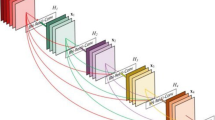Abstract
This paper presents a deep learning based solution for identification of normal and abnormal candle flames, controlled and uncontrolled flames. Candle flames affected by external factors like wind, improper combustion of fuel etc. Proposed CNN based deep neural network can successfully classify the stable and unstable candle flame with an accuracy of 67% for generated test set and an accuracy of 83% for random images taken from open source on internet.
Supported by University Women’s Polytechnic, Aligarh Muslim University.
Access this chapter
Tax calculation will be finalised at checkout
Purchases are for personal use only
Similar content being viewed by others
References
Candle-us-august 2013. https://store.mintel.com/candles-us-august-2013. Accessed 12 Mar 2019
Candles. https://www.nfpa.org/Public-Education/Fire-causes-and-risks/Top-fire-causes/Candles. Accessed 12 Mar 2019
Abdurakipov, S., Gobyzov, O., Tokarev, M., Dulin, V.: Combustion regime monitoring by flame imaging and machine learning. Optoelectron. Instrum. Data Process. 54(5), 513–519 (2018)
Akintayo, A., Lore, K.G., Sarkar, S., Sarkar, S.: Prognostics of combustion instabilities from hi-speed flame video using a deep convolutional selective autoencoder. Int. J. Prognostics Health Manag. 7(023), 1–14 (2016)
Allan, K.M., Kaminski, J.R., Bertrand, J.C., Head, J., Sunderland, P.B.: Laminar smoke points of wax candles. Combust. Sci. Technol. 181(5), 800–811 (2009)
Alsairafi, A., Lee, S.T., T’ien, J.S.: Modeling gravity effect on diffusion flames stabilized around a cylindrical wick saturated with liquid fuel. Combust. Sci. Technol. 176(12), 2165–2191 (2004)
Ballester, J., García-Armingol, T.: Diagnostic techniques for the monitoring and control of practical flames. Prog. Energy Combust. Sci. 36(4), 375–411 (2010)
Buckmaster, J., Peters, N.: The infinite candle and its stability—a paradigm for flickering diffusion flames. In: Symposium (International) on Combustion, vol. 21, pp. 1829–1836. Elsevier (1988)
Chen, T., Guo, X., Jia, J., Xiao, J.: Frequency and phase characteristics of candle flame oscillation. Sci. Rep. 9(1), 1–13 (2019)
Faraday, M.: The Chemical History of a Candle. Courier Corporation (2002)
Hamins, A., Bundy, M., Dillon, S.E.: Characterization of candle flames. J. Fire. Prot. Eng. 15(4), 265–285 (2005)
Li, N., Lu, G., Li, X., Yan, Y.: Prediction of NOx emissions from a biomass fired combustion process based on flame radical imaging and deep learning techniques. Combust. Sci. Technol. 188(2), 233–246 (2016)
Muhammad, K., Ahmad, J., Baik, S.W.: Early fire detection using convolutional neural networks during surveillance for effective disaster management. Neurocomputing 288, 30–42 (2018)
Riley, N.: A sheet model for the candle flame. Proc. R. Soc. Lond. Ser. A: Math. Phys. Sci. 442(1915), 361–372 (1993)
Sandler, M., Howard, A., Zhu, M., Zhmoginov, A., Chen, L.C.: MobileNetV2: inverted residuals and linear bottlenecks. In: Proceedings of the IEEE Conference on Computer Vision and Pattern Recognition, pp. 4510–4520 (2018)
Sarkar, S., et al.: Early detection of combustion instability from hi-speed flame images via deep learning and symbolic time series analysis. In: Annual Conference on of the Prognostics and Health Management (2015)
Sunderland, P., Quintiere, J., Tabaka, G., Lian, D., Chiu, C.W.: Analysis and measurement of candle flame shapes. Proc. Combust. Inst. 33(2), 2489–2496 (2011)
Wang, Q., Hu, L., Palacios, A., Chung, S.H.: Burning characteristics of candle flames in sub-atmospheric pressures: an experimental study and scaling analysis. Proc. Combust. Inst. 37(2), 2065–2072 (2019)
Author information
Authors and Affiliations
Corresponding author
Editor information
Editors and Affiliations
Rights and permissions
Copyright information
© 2021 Springer Nature Singapore Pte Ltd.
About this paper
Cite this paper
Khan, A., Ansari, M.S. (2021). Deep Learning Based Stable and Unstable Candle Flame Detection. In: Thampi, S.M., Piramuthu, S., Li, KC., Berretti, S., Wozniak, M., Singh, D. (eds) Machine Learning and Metaheuristics Algorithms, and Applications. SoMMA 2020. Communications in Computer and Information Science, vol 1366. Springer, Singapore. https://doi.org/10.1007/978-981-16-0419-5_5
Download citation
DOI: https://doi.org/10.1007/978-981-16-0419-5_5
Published:
Publisher Name: Springer, Singapore
Print ISBN: 978-981-16-0418-8
Online ISBN: 978-981-16-0419-5
eBook Packages: Computer ScienceComputer Science (R0)



